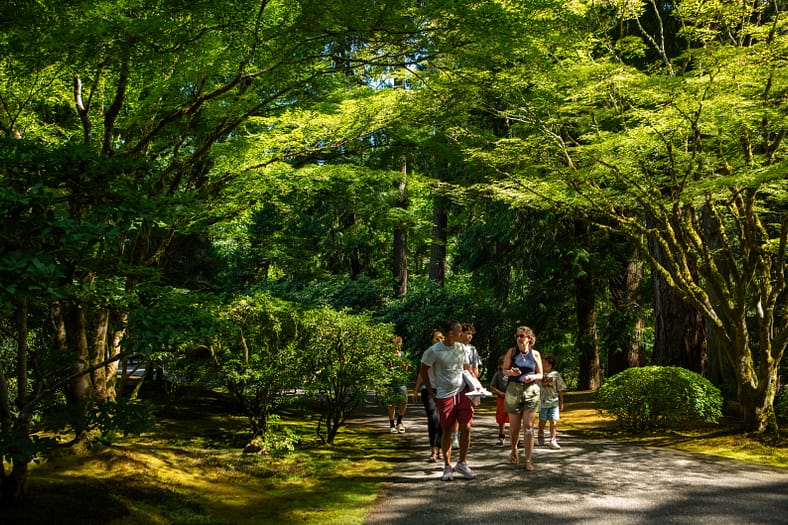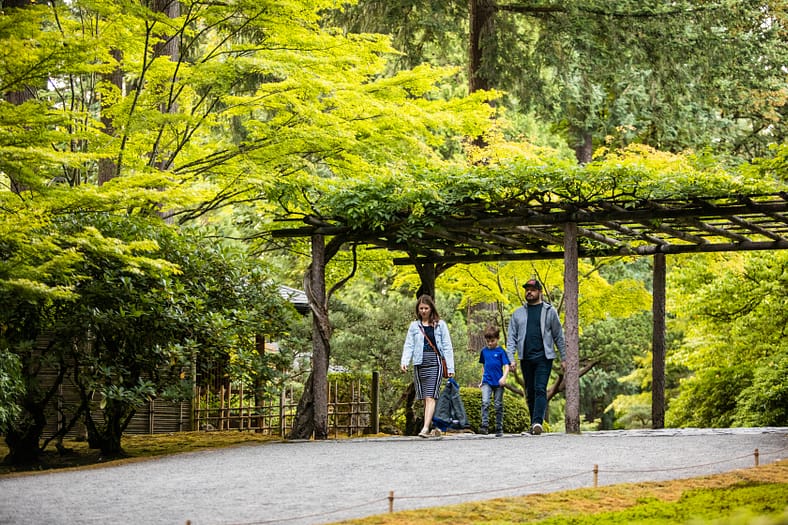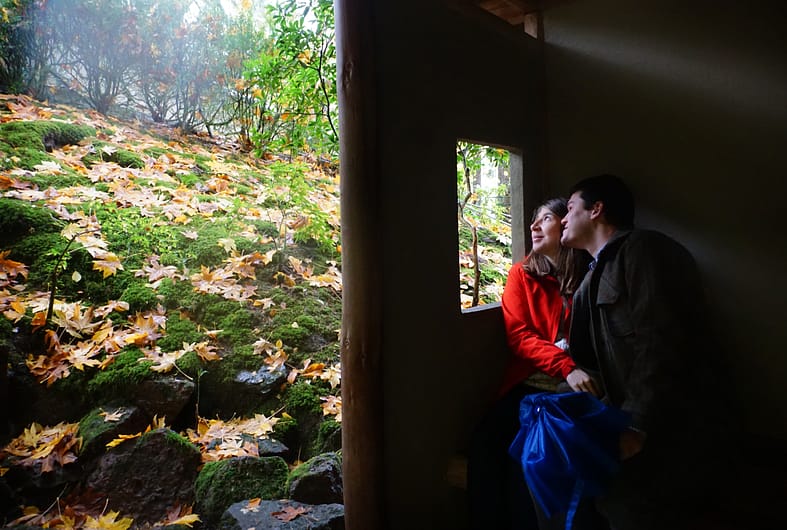
Portland Japanese Garden Communications Manager Will Lerner wrote an article on forest bathing for the latest issue of Public Garden, a publication produced by the American Public Garden Association. This article is also available here, beginning on page 8.
Our built environment, where we hear motors more than bird songs and feel plastic and silicone more than earth and flora, may feel natural to us today. However, we would do well to remember that our modern-day society constitutes a mere fraction of humanity’s presence on Earth.
For hundreds of thousands of years, long before the concept of civilization, we lived more seamlessly as a part of nature. It was only some 250 years ago that the Industrial Revolution gave us our newly manufactured existence,1 and it has not even been twenty years since urban settings outpopulated rural ones.2 For all the many differences we may see between us and our ancestors who roamed the wild, their experiences are etched into our DNA. Like petroglyphs, these experiences are still readable millennia later.
This helps to partially explain the power of the public garden. In such places, the balance tilts back to a comfort we once knew so well. In a space like the Portland Japanese Garden, stones, water, and plants harmonize beneath a canopy of fir and cedar. The curated nature here is shaped by humans, but it also shapes us—it softens our tension, mitigates our anxieties, and satisfies our fundamental desire to feel we belong. Gardens are something more than an adorned landscape or light trifle to kill time—they are a complement to preventative physiological and psychological healthcare.

Of the more formalized approaches to leveraging the special qualities of nature, forest bathing, or as it was first coined in Japanese, shinrin yoku, has started to grow momentum in the American cultural zeitgeist. Only popularized as a term in 1982 by Tomohide Akiyama, then Director of the Japanese Forestry Agency, it can be thought of as the intentional practice of surrounding oneself in nature and being mindful of each sense3—something more conscious and unplugged than staring at a smartphone underneath a tree. The term may be relatively young, but the concept is something that dates back throughout the Holocene Epoch in Earth’s geological history. Scholarly work suggests that Cyrus the Great, founder of the Persian Achaemenid Empire in 550 BCE, built gardens with the intention of improving his peoples’ health.4
This pursuit of mindfulness is not necessarily something that always happened because of high decree. In the American concentration camps of Japanese and Japanese Americans during the World War II era, incarcerees would build Japanese gardens on their prison grounds, seeking emotional relief in the aftermath of their livelihoods being stripped from them.5
Organizations such as the Association of Forest and Nature Therapy have worked to professionalize these activities by offering certification and training, however it is still a burgeoning field. A systematic review of studies on shinrin yoku have found that it has been offered in increments as short as fifteen minutes and as long as nine days and manifested in a wide variety of activities, including walking, meditation, and even arts and crafts.6

As its format is still being shaped by its practitioners, the results of forest bathing are coming into clearer view. Research has indicated that a variety of forest bathing activities are associated with positive health outcomes and reveals that even different logistical approaches, such as the length of time spent or specific actions (e.g., walking, sitting) can correlate to beneficial outcomes. The practice is connected with reductions in heart rate,4 stimulation of the parasympathetic nervous system (i.e., a person’s “rest and digest” processes),1 lowered blood pressure,7 and increases in natural killer cells.8
Beyond the physiological, studies have noted that there are mental health benefits, as well. A systematic review from Antonelli, Barbieri, and Donelli noted a correlation between shinrin yoku and reduced stress levels, improvement in the mindset of patients with post-traumatic stress disorder, better sleep for individuals with menopause-related insomnia, better moods for those addicted to alcohol, and lessened anxiety.9
It is essential to note that in a world being besieged by spurious and unfounded claims on science, the apparent preventative health care benefits of forest bathing does not mean it is a miracle drug alternative to treatment from medical professionals. Positive findings aside, the science is still emerging and is yet to have been globalized; there are few studies being conducted outside of Asia. Furthermore, until a standardized practice has reached some kind of consensus, the fluid definition of forest bathing means it can be so many things and also nothing at all. There are also innumerous confounding variables; it is unclear exactly how much the environment or cultural history of a given region may overstate or understate forest bathing’s potential as a kind of medical treatment.

This important detail noted, the benefits of shinrin yoku are gaining notice and support from officials. The term was initially a marketing exercise to connect self-care with tourism, but is now a tool in Japan’s national health program.10 Dozens of forest medicine centers are coordinating primary care centers across the nation’s major cities.11 In 2008, the nonprofit Forest Therapy Society of Japan was established to monitor scholarly work on the subject, promote it to the public, and administer qualification exams for practitioners. They worked in partnership with institutions both in and outside of government to form a certification process for forest therapy bases, something the Japanese government had initiated as early as 2005. Since 2020, at least sixty-five bases have been established.12 In the United Kingdom, the government agency Forestry England has partnered with The Forest Bathing Institute to offer forest bathing sessions.13
Despite its nascence, forest bathing is becoming more accessible in more places. The American Association of Nature and Forest Therapy Guides and Programs, founded in 2012, offers a searchable network of recognized forest bathing practitioners as well as a six-month certification pathway that includes remote and in-person training. Because of their national network, many public gardens are likely within proximity to these professionals.
Portland Japanese Garden, immersed in the famous towering trees of the Pacific Northwest, offers “mindfulness tours” that aligns with the spirit of forest bathing. Not strictly a meditation experience, but led by one with training in that field, attendees are guided on a contemplative stroll winding through spaces specifically designed to evoke serenity. The guests are asked to make observations about and connect themselves to the landscape. Over the course of the hour, gentle guidance steers the mind away from the obligations and pressures of life to the peace-inducing gifts of nature.

Cecily Hunt, one of Portland Japanese Garden’s cherished volunteers who has led these experiences, notes that the relief people feel after these walks is tangible. Recalling feedback she received in person, Hunt shares that one guest told her, “For me the mindfulness tour was transcendental. Most of the time when I visit, I’m thinking, intellectualizing the experience, but this tour guided me into feeling the Garden. I didn’t try to put the experience into words; I just noticed what I was feeling from moment to moment. I felt good.”
Dr. Yoshifumi Miyazaki of Chiba University, whose expertise gained international recognition upon the publication of his book, Shinrin Yoku: The Japanese Art of Forest Bathing, writes: “Pay attention to any areas of stiffness or pain in the body and consciously relax them. Become aware of your present mental and emotional states…Pay attention to the experience of walking and keep your awareness engaged in this experience. Be aware of the beginning, the middle, and the end of your stepping. Walk as silently as possible.”
Forest bathing programs can find a home within any public garden. It is not a strenuous hike, nor does it require one to be on their feet, so it is something individuals with mobility concerns can enjoy. Furthermore, because public gardens are attractions meant for all audiences, they provide a simpler entry into nature than a hiking trail in the wild. Dr. Qing Li of Tokyo’s Nippon Medical School writes in his book, Forest Bathing, that a vast array of different activities can qualify under the principles of shinrin yoku, including walking, yoga, eating, meditation, art classes, and plant observation.14
Our human tendency to affix labels on the world around us can sometimes unnecessarily limit our perceptions of a person, place, or, in this case, an activity. Just as forest bathing does not require a water-filled bathtub, neither does it require an actual forest. Across the United States, other gardens offer forest bathing and similar nature-based therapy programming in environments that, on first blush, don’t evoke thoughts of woodlands. RoHoEn, the Japanese Friendship Garden of Phoenix, for example, offers a beautiful landscape and certainly has lovely trees, but it is situated in an arid landscape under the blue expanse of an Arizona sky. They nevertheless offer forest bathing led by Association of Nature and Forest Therapy-certified nature guides.16
Additionally, a public garden need not be Japanese in its design and influence to offer shinrin yoku. Leach Botanical Garden in Portland, Oregon, demonstrates this principle by offering forest bathing walks similar to those which have been offered at Portland Japanese Garden—guided strolls that “help participants move beyond the chatter of the thinking mind and find a deeper sense of embodied engagement.”17
The quintessential trait of shinrin yoku is mindfulness in nature, not the specifics of the vegetation. Gardens in any corner of the world can offer this chance to be immersed back in the world that may have vanished from our view, but never left our makeup.
Written by Will Lerner, Communications Manager for Portland Japanese Garden and Japan Institute.
Works Cited
- Song, C., Ikei, H., & Miyazaki, Y. (2016). Physiological effects of nature therapy: A review of the research in Japan. International Journal of Environmental Research and Public Health, 13(8), 1-1. https://doi.org/10.3390/ijerph13080781
- Ritchie, H. & Roser, M. (2018). Urbanization. Our World In Data.org. https://ourworldindata.org/-urbanization
- Miyazaki, Y. (2018). Shinrin yoku: The Japanese art of forest bathing. Timber Press.
- Hansen, M. M., Jones, R., & Tocchini, K. (2017). Shinrin-yoku (forest bathing) and nature therapy: A state-of-the-art review. International Journal of Environmental Research and Public Health, 14(8), 851. https://doi.org/10.3390/ijerph14080851
- Clark, B. (2020). Finding solace in the soil: An anthology of gardens and gardeners at Amache. University Press of Colorado.
- Kotera, Y., Richardson, M., & Sheffield, D. (2020). Effects of shinrin-yoku (forest bathing) and nature therapy on mental health: A systematic review and meta-analysis. International Journal of Mental Health and Addiction, 20(1), 337-361. https://doi.org/10.1007/s11469-020-00363-4
- Farrow, M. R., & Washburn, K. (2019). A review of field experiments on the effect of forest bathing on anxiety and heart rate variability. Global Advances in Health and Medicine, 8, 2164956119848654-2164956119848654. https://doi.org/10.1177/2164956119848654
- Yu, C., Lin, C., Tsai, M., Tsai, Y., & Chen, C. (2017). Effects of short forest bathing program on autonomic nervous system activity and mood states in middle-aged and elderly individuals. International Journal of Environmental Research and Public Health, 14(8), 897. https://doi.org/10.3390/ijerph14080897
- Antonelli, M., Donelli, D., Carlone, L., Maggini, V., Firenzuoli, F., & Bedeschi, E. (2021). Effects of forest bathing (shinrin-yoku) on individual well-being: An umbrella review. International Journal of Environmental Health Research, 32(8), 1842-1867. https://doi.org/10.1080/-09603123.2021.1919293
- Farkic, J., Isailovic, G., & Taylor, S. (2021). Forest bathing as a mindful tourism practice. Annals of Tourism Research Empirical Insights, 2(2), 100028. https://doi.org/10.1016/-j.annale.2021.100028
- Muro, A., Feliu-Soler, A., Canals, J., Parrado, E., & Sanz, A. (2022). Psychological benefits of forest bathing during the COVID-19 pandemic: A pilot study in a Mediterranean forest close to urban areas. Journal of Forest Research, 27(1), 71-75. https://doi.org/10.1080/13416979.2021.1996516
- Zhang, Z. & Ye, B. (2022). Forest therapy in Germany, Japan, and China: Proposal, development status, and future prospects. Forests, 13(8), 1289; https://doi.org/10.3390/f13081289
- The Forest Bathing Institute. (2019). Press release: TFBI & Forestry England partnership launch. https://tfb.institute/press-release-tfbi-forestry-england-partnership-launch/
- Li, Q. (2018). Forest bathing: How trees can help you find health and happiness. Penguin Random House.
- Japanese Friendship Garden of Phoenix. (2023). Shinrin-yoku workshop. https://www.japanesefriendshipgarden.org/event-details/shinrin-yoku-workshop-2023-09-12-18-00
- Leach Botanical Garden. (n.d.). Forest bathing. https://www.leachgarden.org/forest-bathing